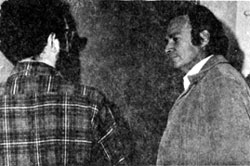Topical Conference Proves Popular Here

R.P. Feynman (R) and H. Abarbanel at blackboard session
following topical conference
Photo by Tony Frelo, NAL
The first in a series of topical conferences arranged by the NAL Theoretical Physics Group brought 125 participants to the Laboratory on Friday and Saturday, December 8 and 9, 1972. Topic for this session was "Quarks and Partons: What Good Are They?" The word "parton" was coined a few years ago by R. P. Feynman of Caltech, a featured speaker at the conference, to describe point-like particles that are possible constituents of protons, the particles accelerated at NAL. "Quarks," originally proposed by Gell-Mann and Zweig in 1963, as building blocks for protons and other particles in order to correlate certain observed patterns or symmetries, and so far unseen as separate entities, may be related to or be the same as partons. As the title of the meeting implied, there were questions in the minds of some physicists as to the reality and usefulness of both partons and quarks. The purpose of the conference was to marshal the evidence in support of these concepts and to discuss experimental means of testing the hypotheses further.
The format for the meetings featured a review of the topic from an experimental viewpoint, followed by a panel discussion, then a review of the salient theory, followed by another discussion. B. Barish (Cal Tech) presented the experimental review talk on Friday afternoon, and a panel led by T. Yamanouchi (NAL), and including E. Paschos (NAL), H. Frisch (University of Chicago), P. Freund (University of Chicago), and D. Miller (Northwestern University), questioned Barish followed by active audience participation. On Saturday morning, Feynman spoke to the group, and a panel chaired by S.D. Ellis (NAL) with J. Cronin (University of Chicago), M. Kislinger (also of Chicago), A.D. Krisch (University of Michigan), and C. Quigg (NAL/Stony Brook), led group discussion.
Dinner in the NAL Cafeteria offered further opportunity for informal exchanges by participants.
According to Henry D. I. Abarbanel of the NAL Theoretical Physics Group, who organized the conference with T. Sanda, this meeting and succeeding topical conferences will help to stimulate a center in the Midwest at NAL for the exchange of communications between theorists and experimentalists. The informal no-invitation basis of attendance brought persons most interested in the subject at hand, according to Abarbanel. There will be no proceedings issued.
"The two talks focused directly on experimental measurements that are crucial to the ideas of parton and quark models, particularly the ideas that link partons directly with quarks," reports Abarbanel. "In some sense nothing brand new developed, but the pedagogical value of the focus on key issues was very significant. Feynman's discussion of photon-hadron interactions in front of experimentalists doing the work, at a time when new experimental data are being analyzed, was very important."
"The format of one lengthy and comprehensive presentation at each session, rather than a series of shorter papers covering different aspects, seemed to work well," reported J. D. Jackson, who was head of the Theoretical Physics group. "The invited speaker had time to develop the subject logically and coherently and at a reasonable pace."
A second topical conference (on diffractive phenomena) was being planned for early March, 1973. Attendance again will be on a first-come, first-served basis in response to the general announcement to be issued soon.


